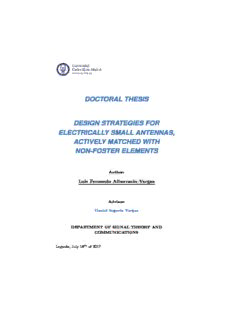
Design strategies for electrically small antennas, actively matched with non-foster elements PDF
Preview Design strategies for electrically small antennas, actively matched with non-foster elements
www.uc3m.es DOCTORAL THESIS DESIGN STRATEGIES FOR ELECTRICALLY SMALL ANTENNAS, ACTIVELY MATCHED WITH NON-FOSTER ELEMENTS Author: Luis Fernando Albarrac´ın-Vargas Advisor: Daniel Segovia Vargas DEPARTMENT OF SIGNAL THEORY AND COMMUNICATIONS Legan´es, July 18th of 2017 DOCTORAL THESIS DESIGN STRATEGIES FOR ELECTRICALLY SMALL ANTENNAS, ACTIVELY MATCHED WITH NON-FOSTER ELEMENTS Author: Luis Fernando Albarrac´ın-Vargas Advisor: Dr. Daniel Segovia-Vargas Firma del Tribunal Calificador: Firma Presidente: Prof. Miloˇs Maz´anek Secretario: Prof. Luis Enrique Garc´ıa-Mun˜oz Vocal: Prof. Marco A. Antoniades Calificaci´on: Legan´es, July 18th of 2017 A mi familia. La vida no es la que uno vivi´o, sino la que uno recuerda, y c´omo la recuerda para contarla. What matters in life is not what happens to you but what you remember and how you remember it. Gabriel Garc´ıa-Ma´rquez CONTENTS Contents vii Agradecimientos / Acknowledgements xi Resumen xiii Abstract xv Terms and Abbreviations xvii Preface xxi 1. Introduction 1 1.1. Description of the Problem . . . . . . . . . . . . . . . . . 1 1.1.1. Definition of an Electrically Small Antenna (ESA) 2 1.2. Typical Applications of ESAs . . . . . . . . . . . . . . . . 3 1.3. Fundamental Performance Properties of an ESA . . . . . 5 1.4. Active Circuits Applied to Impedance Matching. . . . . . 9 1.4.1. Possible Applications of Actively Matched Small Antennas . . . . . . . . . . . . . . . . . . . . . . . 12 1.5. Motivation, Objectives and Contribution . . . . . . . . . . 13 1.6. Organization of the Dissertation . . . . . . . . . . . . . . 14 2. Impedance Matching Techniques for ESAs: Background 17 2.1. Fundamental Parameters of Antennas . . . . . . . . . . . 17 2.1.1. Radiation Pattern . . . . . . . . . . . . . . . . . . 17 2.1.2. Directivity . . . . . . . . . . . . . . . . . . . . . . 19 2.1.3. Gain . . . . . . . . . . . . . . . . . . . . . . . . . . 20 2.1.4. Effective Aperture Area and Aperture Efficiency . 21 2.1.5. Phase Pattern and Phase Center . . . . . . . . . . 22 2.1.6. Polarization . . . . . . . . . . . . . . . . . . . . . . 22 2.1.7. Input Impedance . . . . . . . . . . . . . . . . . . . 23 2.1.8. Radiation Resistance . . . . . . . . . . . . . . . . . 23 2.1.9. Bandwidth . . . . . . . . . . . . . . . . . . . . . . 24 2.2. A Brief History of Electrically Small Antennas . . . . . . 25 2.3. Classification and Most Typical ESA Structures. . . . . . 27 2.4. Performance Characteristics of ESAs . . . . . . . . . . . . 28 2.4.1. Antenna Impedance of an ESA . . . . . . . . . . . 29 2.4.2. Quality factor Q . . . . . . . . . . . . . . . . . . . 31 2.4.3. Bandwidth and Passive Matching . . . . . . . . . . 34 2.4.4. Radiation efficiency . . . . . . . . . . . . . . . . . 36 2.5. Passive Impedance Matching Constraints . . . . . . . . . 36 2.6. Impedance Matching Using Active & non-Foster Networks 39 2.6.1. Tunable Antennas Technique . . . . . . . . . . . . 41 2.6.2. Non-Foster Impedance Matching: Concept. . . . . 43 2.6.3. Foster’s Reactance Theorem and non-Foster Elements . . . . . . . . . . . . . . . . . . . . . . . 45 2.7. Transistor-based Non-Foster Elements: Realizations . . . 47 2.7.1. Negative Impedance Converters (NICs) . . . . . . 47 2.7.2. Negative Impedance Inverters (NIIs) . . . . . . . . 53 2.8. Negative Impedance Converters for ESAs . . . . . . . . . 58 2.8.1. Cascade and Series Topologies . . . . . . . . . . . 58 2.8.2. Embedded non-Foster Matching Networks . . . . . 64 3. Embedded Non-Foster Matching Networks for ESAs 67 3.1. Introduction . . . . . . . . . . . . . . . . . . . . . . . . . . 67 3.2. Two-Port Antenna Approach for Active Impedance Matching . . . . . . . . . . . . . . . . . . . . . . . . . . . 69
Description: